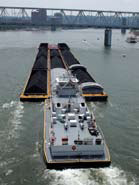2010 Report Card for Pennsylvania's InfrastructureKeystone In Crisis |
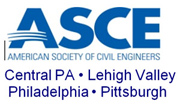 |
Infrastructure Grades

Bridges Of Pennsylvania’s 22,280 bridges, 27% are considered structurally deficient and 17% are deemed functionally obsolete. These figures mean increased traffic congestion as well as forcing emergency vehicles to take lengthy detours due to speed or weight restrictions. PennDOT’s emphasis on bridges through their accelerated bridge program has allowed these numbers to hold steady despite the advancing age of the Commonwealth’s bridge inventory. Further emphasis on the bridge program and proper funding of bridge replacement and rehabilitation will help push trends in a positive direction. However, the recently rejected I-80 tolling proposal means the Pennsylvania legislature is now faced with the task of coming up with new sources of funding to cover critically underfunded transportation needs, including $11 billion in immediately needed bridge repairs.
Read the full report…
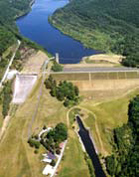
Dams and Levees Due to the establishment of the Pennsylvania Department of Environmental Protection’s Dam Safety Program in the late 1970s, Pennsylvania has remained ahead of other states in dam safety. However, about 39% (302) of the state’s “high hazard” dams—dams whose failure would cause probable loss of human life and substantial property damage — are considered deficient. The estimated cost to repair all Pennsylvania dams projected to be found deficient over the next five years is more than $1.4 billion. There are 64 levee systems in Pennsylvania, and the average age of those systems is 43 years; about one-third are older than 50 years. The advanced age of the levee systems also casts doubt on their ability to perform without incident or failure.
Read the full report…
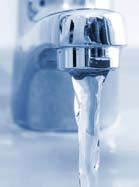
Drinking Water Pennsylvania faces a required investment of $15.5 billion over the next 20 years to replace aging facilities and comply with safe drinking water regulations. Although waterborne outbreaks are currently near zero, the number of drinking water systems in violation of regulations is on the rise. Funding research into new wastewater treatment technology and reducing water waste and consumption will help reduce costs, but construction and repair of drinking water facilities will require a steady source of funding. Drinking water systems must adopt full-cost pricing in water billing to reflect operational and maintenance costs as well as raising funds for eventual replacement. If funding needs are not met, the state risks reversing the public health, environmental and economic gains that have been made over the past three decades.
Read the full report…
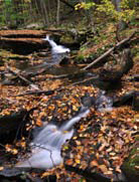
Parks and RecreationIn 2009, Pennsylvania’s State Parks were awarded the National Gold Medal Award for Excellence in Park and Recreation Management by the American Academy for Park and Recreation Administration, recognizing the state’s parks as the among the nation’s best. The state owes some of the parks’ success to the Growing Greener II Act, or Act 45, through which Pennsylvania invested $625 million in agricultural and environmental resources in 2005. But tax revenues are falling and the GGII initiative will reach its terminus in 2010, leaving another major gap in the funding needs for continued maintenance and improvements to the state’s parks and recreational facilities. In 2009, demand was expected to exceed funding by almost $160 million a year. Additional legislation must be proposed to meet funding needs for parks and recreation so that Pennsylvania can continue as a leader in managing and sustaining its state parks, forests and recreational areas.
Read the full report…

Freight Rail In 2007, 201.6 million tons of freight passed through the Commonwealth. By 2035, that value is expected to be 246 million tons. Railroad freight demand is growing at a rate much faster than the general population, and while the state of much of Pennsylvania’s rail freight system is good, investment in rail infrastructure will need to increase to meet growing demands. Class I and Class II railroads are in a better position to cover their own financial needs, but crucially important smaller railroads are not, and will need more assistance to remain competitive.
Read the full report…

Roads International Roughness Index statistics show that 38% of Pennsylvania’s roads are rated fair or poor. Pennsylvania’s highway network (40,000 state and 76,000 local miles) ranks as 5th largest in the nation for the number of state-owned highways. Truck traffic on Pennsylvania’s 1,754 miles of interstate roads is more than double the national average, and many of the state’s roads are at or exceed their design capacity. Although recent economic challenges have resulted in a leveling in travel demand on our roadways, temporarily reducing the rate of increase of congestion and travel time, that demand is predicted to rise greatly in the near future. The FHA’s rejection of the I-80 tolling proposal will result in a cut of $312 million annually from transportation infrastructure funding. PennDOT’s current focus is on maintenance of existing roads, and while ARRA has provided more than $600 million for road projects in Pennsylvania, this one-time funding allocation does not cover the amount required even to maintain our state’s roads adequately for a single year and does nothing to address future capacity needs.
Read the full report…

Schools Information on the infrastructure of our public and charter schools is just beginning to be more available as more districts participate in the Department of Education’s facility surveys, and statistics indicate the state of school buildings is overall good. The 2007-08 report from the Division of School Facilities rated fewer than 6% of schools in Poor Condition, with 28% rated as fair, 36% good and 29% excellent. However, a clear picture of Pennsylvania’s school infrastructure can only emerge with greater participation in surveys. Currently only 55% of school districts and 44% of Career and Technical Centers report information to the DOE.
Read the full report…

Solid Waste Based on EPA figures, landfills in Pennsylvania collectively had a remaining average capacity life of 16 years as of January 2009, and few new permits are being granted for new landfill sites, due to changes made to the state approval process. While recycling programs in the state have greatly expanded in the last two decades, various obstacles still exist to more efficient and widespread use of these programs to reach the EPA’s national recycling rate goal of 35%. Some of the state’s solid waste is being converted to energy in waste-to-energy facilities, but more research is needed to make this option more cost-effective and technologically feasible.
Read the full report…
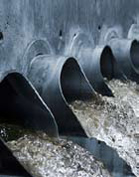
Stormwater Approximately 84% of Pennsylvanians rely on surface water for their drinking water supply. Since stormwater runoff, with its load of chemical and biological contamination, ends up in lakes and reservoirs, stormwater is as important as drinking water and wastewater infrastructure. Improving the state’s stormwater infrastructure will require a dedicated funding source for investigation, operation and maintenance of existing systems, as well as funding for taking the next step to improve water quality and manage water use, and the establishment of a system of stormwater regulatory oversight.
Read the full report…

Transit In recent years, transit use has increased faster than any other mode of transportation. rising more than 4% from 411 million trips in 2007 to 428 million trips in 2008. The 4% increase in transit ridership in 2008 saved more than 186 million gallons of gasoline. In the past, the overall financial underpinning of the Commonwealth’s transit program was weak and the program structure was dysfunctional. Act 44 was passed to address these shortfalls. However, in April 2010, the Federal Government denied the state’s application to toll 1-80, a measure which was to provide more than $472 million annually to the transportation budget, with $160 million dedicated to the Commonwealth’s transit systems. Unless a new long-term solution is found, transit system users throughout the state will face significant service reductions, fare increases, and reduced mobility, especially senior citizens and persons with disabilities. Overall, congestion will increase, air quality will suffer, and the condition and performance of our highway and bridge network will deteriorate.
Read the full report…

Wastewater Aging wastewater management systems discharge billions of gallons of untreated sewage into Pennsylvania’s surface waters each year. It is estimated that the state must invest $28.3 billion over the next 20 years to repair existing systems, upgrade existing systems to meet regulatory requirements (i.e., TMDL’s, Control of Combined Sewer Overflows, etc.) and expansion of existing systems or build new systems to meet increasing demands. Despite the one-time injection of additional funding from the ARRA Stimulus bill, PENNVEST grant and loan awards for sewer projects amounted to $65.0 million dollars or only HALF of the annual need required to meet the $28.3 billion required.
Read the full report…
